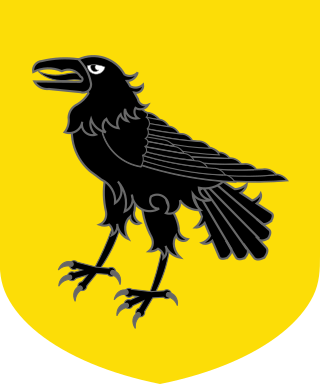
Sir Charles Miles Lambert Monck, 6th Baronet was an English politician. He succeeded to the Baronetcy of Belsay Castle on the death of his father in 1795.
Robert Laurie may refer to:

Sir Robert Laurie, 5th Baronet was a Scottish soldier and politician who sat in the House of Commons from 1774 to 1804.
Sir Robert Laurie 4th Baronet (1708–1779) of Maxwelton, Dumfries was a Scottish politician who sat in the House of Commons from 1738 to 1741

The Palmer Baronetcy, of Carlton in the County of Northampton, was created in the Baronetage of England on 7 June 1660 for the lawyer and politician Geoffrey Palmer. The second Baronet was Member of Parliament for Higham Ferrers. The third, fourth and fifth Baronets all represented Leicestershire in the House of Commons. The fifth Baronet served as High Sheriff of Leicestershire in 1782 and the eighth Baronet as High Sheriff of Northamptonshire in 1871.

The Stapylton baronetcy, or Stapleton, of Myton in Yorkshire, was created in the Baronetage of England on 22 June 1660 for Henry Stapylton.
Sir John Lowther Johnstone, 6th Baronet (1783–1811) was a British Army officer and politician.

The Clarke Baronetcy, of Snailwell in the County of Cambridge, was created in the Baronetage of England on 25 July 1698 for Samuel Clarke. The second Baronet sat as Member of Parliament for Cambridgeshire. The third Baronet was Sheriff of Huntingdonshire and Cambridgeshire between 1753 and 1754. The title became extinct on the death of the sixth Baronet in 1806.

The Scott baronetcy, of Lytchet Minster in the County of Dorset, was created in the Baronetage of the United Kingdom on 8 September 1821 for Claude Scott. The title became extinct on the death of the seventh Baronet in 1961.

The Tyrwhitt Baronetcy, of Stainfield in the County of Lincoln, was created in the Baronetage of England on 29 June 1611 for Philip Tyrwhitt. The fourth Baronet represented Grimsby in the House of Commons. The fifth and sixth Baronets both sat as Members of Parliament for Lincoln. The title became extinct on the latter's death in 1760.

The Corbet baronetcy, of Stoke upon Tern in the County of Shropshire, was created in the Baronetage of England on 19 September 1627 for John Corbet.

Sir Robert Throckmorton, 3rd Baronet, was a member of a prominent English family of Roman Catholic dissenters.

The Russell baronetcy, of Chippenham in the County of Cambridge, was created in the Baronetage of England on 19 January 1629 for William Russell. He represented Windsor in Parliament. The 2nd Baronet sat as Member of Parliament for Cambridgeshire under the Commonwealth. The title is presumed to have become extinct on the death of the 10th Baronet in 1804.

The Kaye baronetcy, of Woodesham in the County of York, was created in the Baronetage of England on 4 February 1642 for John Kaye of Woodsome Hall, Almondbury, Yorkshire. He was a colonel of the Horse in the service of King Charles I during the Civil War. His title was forfeit under the Parliamentarian rule, but was restored after the return of the monarchy in 1660.

The Owen baronetcy, of Orielton in the County of Pembroke, was created in the Baronetage of England on 11 August 1641 for Hugh Owen, Member of Parliament for Pembroke, Haverfordwest and Pembrokeshire.

The Preston baronetcy, of Valleyfield in the County of Perth, was created in the Baronetage of Nova Scotia on 13 March 1637 for George Preston, the son of Sir John Preston and his wife Grizel Colville. The baronetcy came with a grant of 16,000 acres (6,500 ha) in Nova Scotia.
John Stein was a Scottish banker, distiller and politician.

The Barrington Baronetcy, of Barrington Hall in the County of Essex was created in the Baronetage of England on 29 June 1611, for Francis Barrington, member of parliament (MP) for Essex.

The Douglas baronetcy of Kelhead, parish of Cummertrees, Dumfriesshire, was created on 26 February 1668 in the Baronetage of Nova Scotia for James Douglas, son of Sir William Douglas of Kelhead, governor of Carlisle Castle in 1647.

The Lawson baronetcy, of Isell in the County of Cumberland, was created in the Baronetage of England on 31 March 1688 for Wilfrid Lawson. He had been a Member of Parliament for Cumberland and Cockermouth in 1659, 1660 and 1661.
















